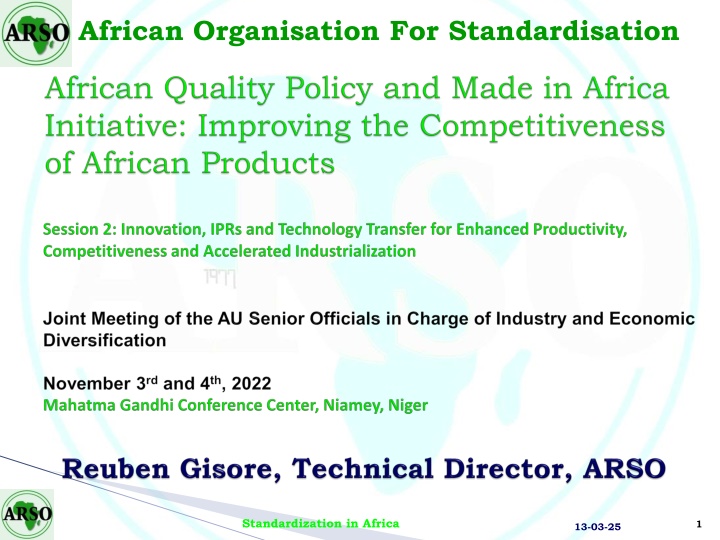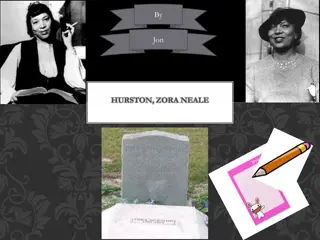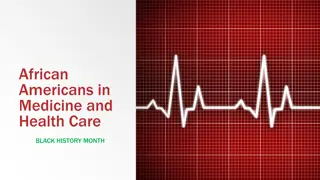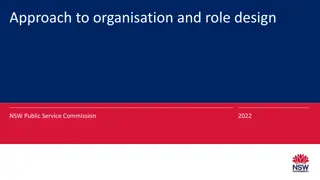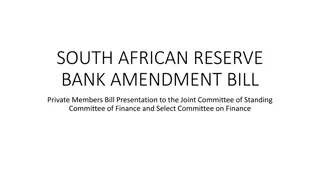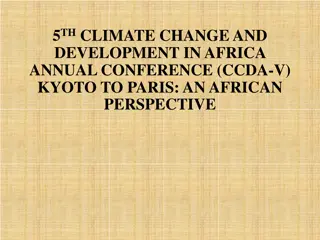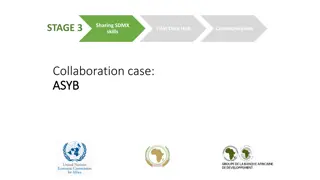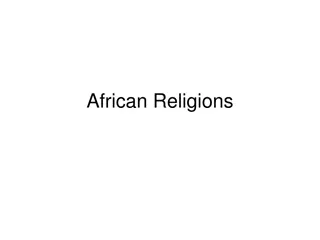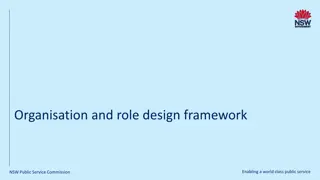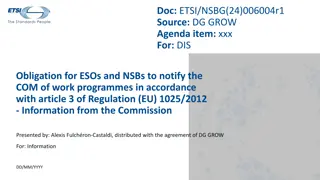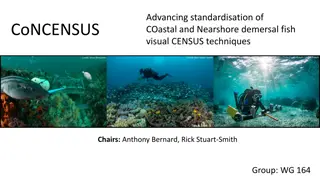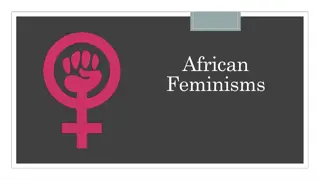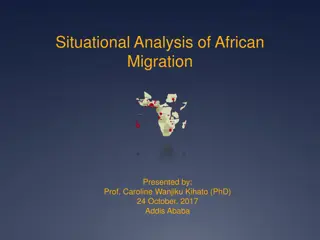African Organisation For Standardisation
Quality policy at national, regional, or continental levels aims to develop efficient Quality Infrastructure (QI) systems to enhance the quality, safety, and environmental soundness of goods, services, and processes. Standardization, metrology, regulation, accreditation, and conformity assessment are essential to ensure products meet defined requirements for international trade. However, challenges include lack of coordinated legislation and regulations, sidelining QI from political discussions, and fragmented regulatory frameworks. Harmonizing policies relating to standards, quality, and technical regulations is crucial for a holistic approach to Quality Infrastructure.
Download Presentation

Please find below an Image/Link to download the presentation.
The content on the website is provided AS IS for your information and personal use only. It may not be sold, licensed, or shared on other websites without obtaining consent from the author.If you encounter any issues during the download, it is possible that the publisher has removed the file from their server.
You are allowed to download the files provided on this website for personal or commercial use, subject to the condition that they are used lawfully. All files are the property of their respective owners.
The content on the website is provided AS IS for your information and personal use only. It may not be sold, licensed, or shared on other websites without obtaining consent from the author.
E N D
Presentation Transcript
African Organisation For Standardisation Standardization in Africa 1 13-03-25
43 Member States 12 Non-Member States
Quality policy in this context means a policy adopted at a national or regional or continental level to develop and sustain an efficient and effective Quality Infrastructure (QI) system Quality organizations (public and private) together with the policies, relevant legal and regulatory framework, and practices needed to support and enhance the quality, safety and environmental soundness of goods, services and processes. Infrastructure is the system comprising the The quality infrastructure is required for the effective operation of domestic markets, and its international recognition is important to enable access to foreign markets. It is a critical element in promoting and sustaining economic development, as well as environmental and social wellbeing. 3 Standardization in Africa 13-03-25
sum of a countrys policy, legal, regulatory and administrative frameworks and the respective public and/or private institutional arrangements necessary to put standardization, metrology, regulation, accreditation and conformity assessment services (inspection, testing and certification) into effective operation. to service and support enterprises and consumers so as to ensure that products and services meet and can be shown to meet defined requirements, with the appropriate recognitions to facilitate international trade. 4 Standardization in Africa 13-03-25
The Quality Policy does not exist on its own: A number of policies already in place contain references to standards, quality, and technical regulations. There is lack of a holistic view of a national QI, nor is there guidance on a common approach to technical regulation The focus is on the specifics of that policy. The Quality Policy should link and coordinate the policy measures relating to standards, quality, and technical regulation contained in all of these important policies. 5 Standardization in Africa 13-03-25
QI may seem to be complex and it is often sidelined from high-level political discussions or left out of a country s development agenda with a focus on short-term gains or single and disparate components of QI without considering the broader interrelationships within the QI ecosystem. This is further fuelled by a patchwork of uncoordinated legislation and regulatory frameworks which are not responsive global trade and food security frameworks. There is lack of appreciation of the need to establish functional interfaces between sector regulatory bodies: SPS, animal health, public health, food safety on the one hand and quality infrastructure bodies: metrology, standards, conformity assessment, accreditation, trade promotion and environmental bodies We see the role of SPS, Metrology, Standards, Testing and Marketing on the same products The beef and poultry meat must pass SPS Measures through Testing and Inspection; the cuts must be Standardized; Measured into marketable portions; Packed, Labelled and Coded as per Trade and Technical Standards, Legal Metrology requirements 6 Standardization in Africa 13-03-25
7 Standardization in Africa 13-03-25
The AQP lays down policy directions for the operation of a continental-level QI, with the aim of aligning the AQP with the policies governing national and REC-level policies All Africa s goods and services comply with relevant standards and technical regulations and are competitive on regional and international markets. To assist Africa s enterprises in becoming globally more competitive, including better integration into regional and international value chains, through enhanced trade facilitation and sustainable industrialization To assure that the continental QI is aligned to and compliant with international best practices, regional requirements and international agreements to which AU Member States are party To assure that the technical regulatory framework complies with the requirements of the AfCFTA and the WTO TBT Agreement through the application of good regulatory practices To provide for arrangements for the mutual acceptance of conformity assessment procedures among Member States in the areas of inspection, certification, testing and calibration Standardization in Africa 8 13-03-25
The AQP seeks to create a cogent Q&RI framework to galvanize institutional support for the aspirations of African countries to participate in intra-African and global trade AQP seeks to create a forward-moving institutional vessel to support Africa s industrialization and development agenda rather than the present fragmented and intellectualized scattering of spheres of control which disorient our aspirations and create illusions of complexity and despair 9 Standardization in Africa 13-03-25
Implementation of this quality policy will be driven with the support of continental institutions responsible for standardization, metrology and accreditation on the continent: The African Organisation for Standardisation (ARSO) The African Electrotechnical Standardisation Commission (AFSEC) The Intra-Africa Metrology System (AFRIMETS) The African Accreditation Cooperation (AFRAC). 10 Standardization in Africa 13-03-25
1. STC-ETIM 2. AQP Council Chair, the AUC Commissioner for Economic Development, Trade, Industry and Mining AfCFTA Secretariat PAQI institutions REC representatives Stakeholder representatives (private sector, consumers, academia). 3. Functions: Monitor and oversee implementation plans 11 Standardization in Africa 13-03-25
Made in Africa is a programme aimed at facilitating Africa s development by: fostering industrialisation Improving productive capacities promoting export diversification protecting intellectual property and intra-Africa trade for brands, products, and services made in the African Continent through creating profitable and sustainable regional, continental and global value-chains. 12 13-03-25 Standardization in Africa
The first aspiration of Agenda 2063 A prosperous Africa based on inclusive growth and sustainable development foresees a situation where there is inclusive economic growth, high agricultural productivity and industrialization which shall add value to Africa s natural resources in order to reduce the dependence of the continent on imported goods and services while exporting raw materials. 13 13-03-25 Standardization in Africa
Africa needs to realize that its future lies within the continent The opportunities are here growing population, rising consumer spending but we can only start to reap the benefits when we start to integrate our economies. .. African Development Akinwumi Adesina (2016) Bank (AfDB) President 14 Standardization in Africa 13-03-25
For Africa to trade with itself, we need to know what we and our neighbours produce, the quality and safety of the products, their social and environmental footprints and how we get the products where and when we need them. 15 Standardization in Africa 13-03-25
The AfCFTA Agreement has among its stated objectives and aims: (a) the creation of a single market for trade in goods and services in accordance with the Pan African Vision of "An integrated, prosperous and peaceful Africa" enshrined in Agenda 2063; (b) the creation of a liberalised market for goods and services aided by the elimination of tariffs and non-tariff barriers to trade in goods or services; (c) enhanced efficiency of customs procedures, trade facilitation and transit; (d) the development and promotion of regional and continental value chains; (e) enhanced socio-economic development, industrialization across Africa. diversification and These objectives can be met when the continent trades in goods and services which are wholly made in Africa or are substantially transformed within the continent with attendant conferring of such goods or services as Made in Africa. 16 13-03-25 Standardization in Africa
(i) Rapid population growth:Africas population is expected to double by 2050, creating huge opportunities in retail and consumer markets. (ii) A young and growing population: the size of Africa s working-age population is expected to surpass both India s and China s by 2034. (iii) Rapid urbanization:By 2025, an additional 190 million people in Africa are expected to be living in urban areas, which means that about 45 percent of the population shall be urbanized by then. Per capita consumption spending in large cities in Africa is on average 79 % higher at the city level than at the national level. (iv) Rising incomes: Since 2005, increases in spending per household have been responsible for about 40 percent of consumption growth in Africa. By 2025, 65 percent of African households shall be in the discretionaryspending income bracket (earning more than $5,000). (v) Promising consumer and business expenditure: Spending by consumers and businesses today totals $4 trillion. Household consumption is expected to grow at 3.8 percent a year to 2025 to reach $2.1 trillion. Business spending is expected to grow from $2.6 trillion in 2015 to $3.5 trillion by 2025. 17 13-03-25 Standardization in Africa
MiA Vision: A continent that is industrialised and trades with itself and globally. MiA Mission: Facilitating Africa s development by fostering industrialisation, productive capacities, promoting export diversification, protecting intellectual property and boosting intra-Africa trade for brands, products, and services made in the African continent Objectives: 1. Promote manufacturing, research and industrial innovation to achieve competitive production of domestic and export-oriented products, including commercialisation of indigenous knowledge and creative economy. 2. Create trust in the quality, safety and value for money of products made in Africa to boost intra-Africa trade and Regional Value Chains and tap into Africa s increasingly wealthy home consumer base. 3. Increase visibility and protection of IPRs, trademarks, brands of African goods and services. 4. Create a favourable environment to mobilize investments across priority sectors of comparative and competitive advantage. 18 13-03-25 Standardization in Africa
Priority Sectors processing Priority Sectors Examples of goods and services Food and feed, fruit and vegetable products, fish, meat, dairy, poultry, etc. Timber, wood products, honey, traditional medicine, essential oils, Iron, steel, copper, gold, gemstones, etc.. Pesticides, fertilizers, medicines, soaps, detergents, etc. Garments, footwear, bags, belts, wallets, Fibres and yarn, fabrics, garments, accessories, Light engineering, medical devices, farming implements, Cement, stone, masonry, roofing materials, metallic materials, glass Fossil fuels, paints, varnishes, Examples of goods and services Agro Agro- -processing Forestry and forestry products Forestry and forestry products Mineral products Chemicals and pharmaceuticals Mineral products Chemicals and pharmaceuticals Leather and leather products Textiles and textile products Machinery, tools and equipment Leather and leather products Textiles and textile products Machinery, tools and equipment Construction materials Construction materials Petro and plastics Tourism, hospitality and creative services Petro- -chemical products, rubber and plastics Tourism, hospitality and creative services chemical products, rubber Destination tourism, hotels, food tourism, beauty and wellness, performing arts, music, films, theatre, arts and crafts. ICT, IoT, Business Processes Outsourcing, Education Ticketing, Clearing and forwarding, Export and Import firms, brokerage and Insurance Knowledge based services Knowledge based services Logistics and transport Logistics and transport Work Progress report 19 13-03-25
1. Make in Africa Shifting of operations to manufacture in the continent. Materials and works meet basic criteria of rules of origin: Bronze level 2. Silver Level: Products meet basic levels of rules of origin. Made under license, francizes, outside designs, patents; substantial transformation 3. Made in Africa Gold Level: Over 50 % materials and works made in Africa. Substantial research and development, 4. Made in Africa Platinum Level: Wholly obtained products. 20 13-03-25 Standardization in Africa
1. Pharmaceuticals and Medical Devices 2. Healthcare Services 3. Automotive Technology and Engineering 4. Cereals, Pulses, Meat, Poultry, Eggs and Food Packaging 5. ARSO-AfDB Dairy, Fisheries and Horticulture 6. ARSO-SADC PROFISHBLUE Fisheries Standards 7. ARSO-UNECA Environmental Standards 8. Supporting quality and regulatory infrastructure, value chain-specific quality infrastructure services and quality culture promotion in the African, Caribbean and Pacific Group of States (UNIDO) 9. Harmonization and Implementation of African Standards for Textiles and Leather Products in Relation to the African Fashion Industry 21 13-03-25 Standardization in Africa
Thank you! ARSO CENTRAL SECRETARIAT 3rd Floor, International House Mama Ngina Street P. O. Box 57363-00200 NAIROBI, KENYA. Tel: +254-020-2224561/3311641/3311608 E-mail: arso@arso-oran.org info@arso-oran.org http: www.arso-oran.org 22 13-03-25
